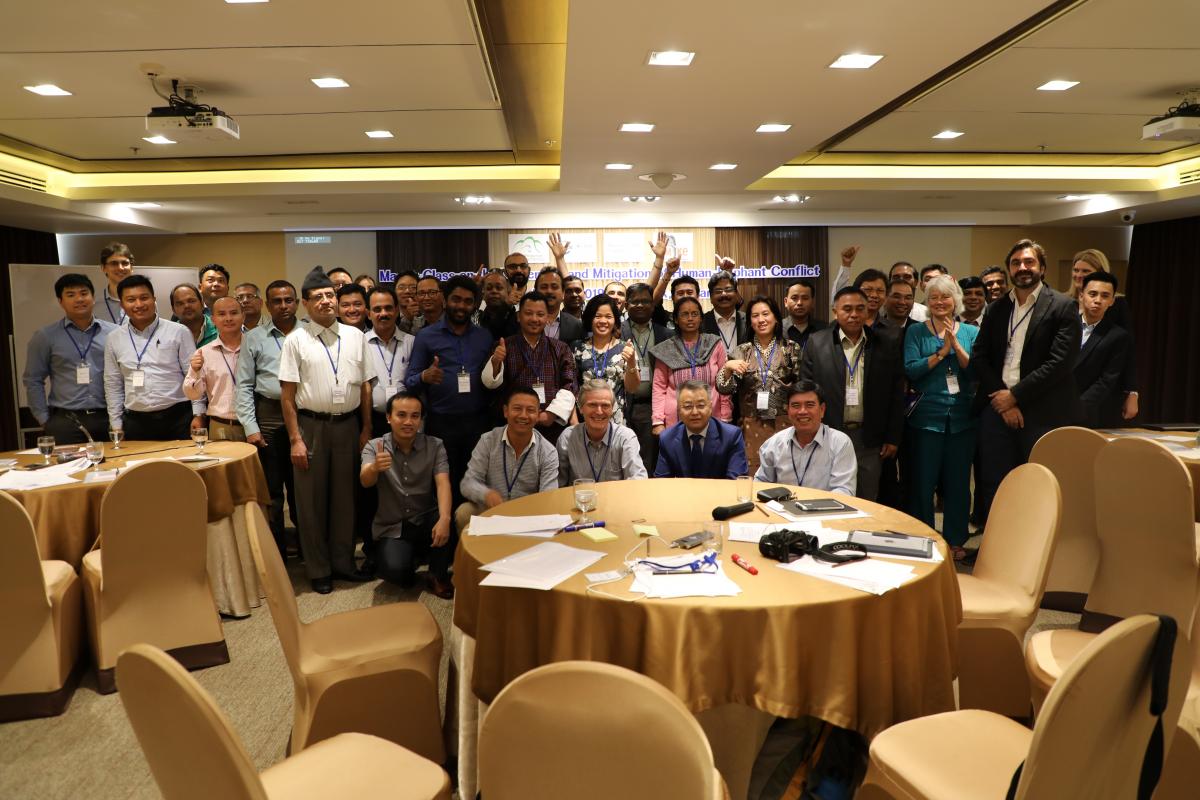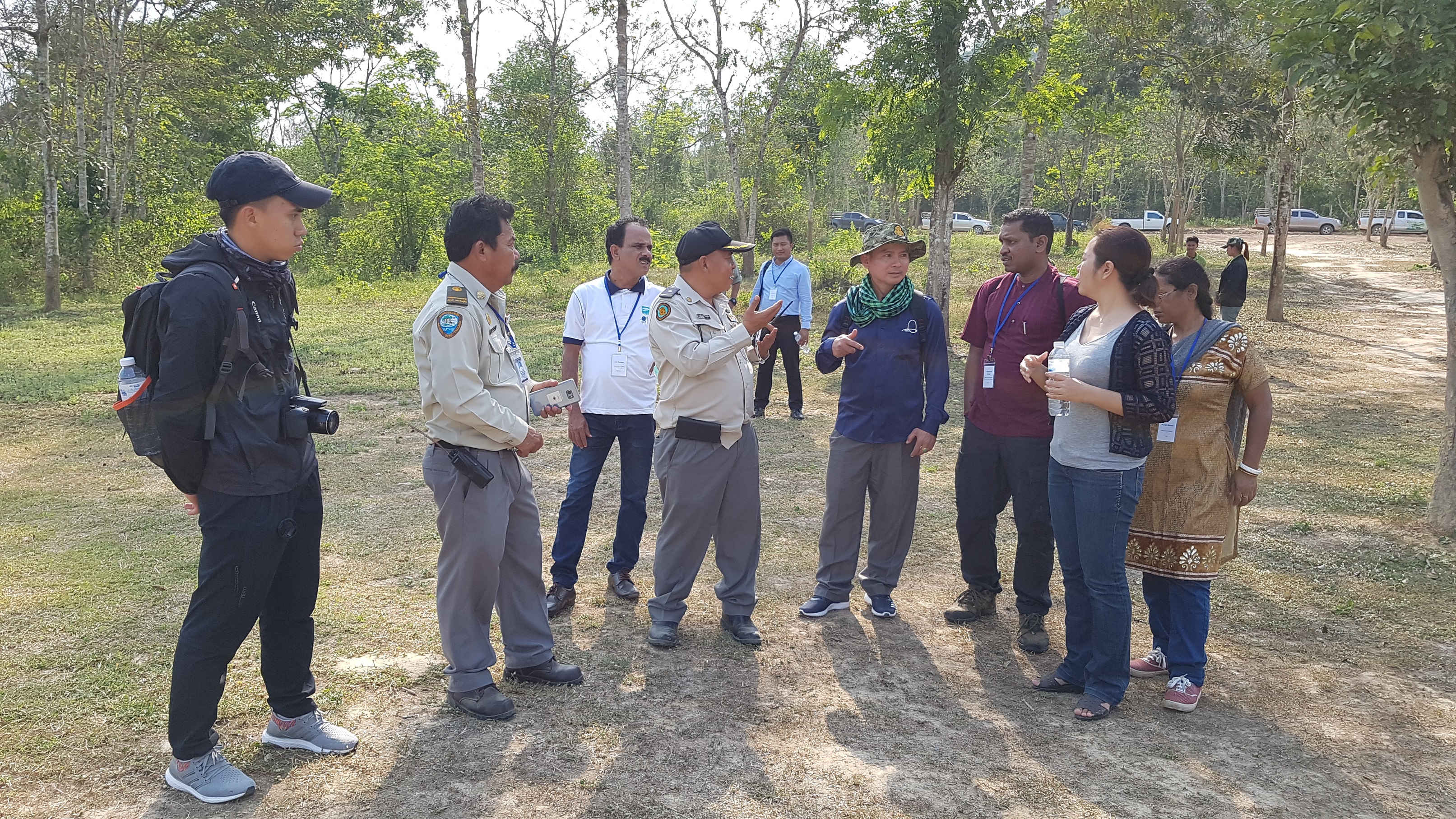Elephants and people: Exploring options for co-existence in Asia
Analysing and understanding the complexities of human-wildlife conflicts and applying appropriate implementation methods and processes adapted to the local context, are critical in the prevention and mitigation of Human-Elephant Conflict (HEC).

Photo: IUCN
This was the clear message that emerged when representatives from 12 Asian countries met in Bangkok, Thailand on 12-15 February to learn more about human-wildlife conflicts, with specific focus on interactions with Asian elephants, as well as implementation methods and processes for mitigating and managing HEC.
The Master Class on the Prevention and Mitigation of Human-Elephant Conflict was organised by the Asia Protected Areas Partnership (APAP) in collaboration with the IUCN SSC Human-Wildlife Conflict Task Force and the Monitoring the Illegal Killing of Elephants (MIKE) programme. It was developed in response to the increasing frequency and severity of human-elephant conflicts across the region. Every year, approximately 600 people die from encounters with elephants, while around 400 elephant mortalities result from anthropogenic causes. India and Sri Lanka, in particular, experience a disproportionately high number of human and elephant mortalities when compared to other Asian countries.
Dr Scott Perkin from the IUCN Asia Regional Office explained that the idea for the Master Class had originated over one year ago, at the APAP workshop on human-wildlife conflict in Bhutan. The workshop had revealed two very important findings: first, that human-wildlife conflict is widespread across the Asian region; and secondly, that virtually every elephant range state is experiencing serious conflicts with elephants.
“In fact, elephants came up so often, and were identified by so many participants as a priority, that we felt it would be worthwhile designing an in-depth follow-up programme focusing just on the mitigation of human-elephant conflict,” said Dr Perkin in his welcome remarks.
 Photo: IUCN
Photo: IUCN
Representatives from Bangladesh, Bhutan, Cambodia, China, India, Lao PDR, Malaysia, Myanmar, Nepal, Sri Lanka, Thailand, and Viet Nam participated in the four-day workshop. Over the course of the event, participants were exposed to a wide range of topics, including elephant ecology, social psychology, social marketing, HEC damage interventions, spatial planning, and monitoring and evaluation.
Resource persons used a combination of presentations, case method teachings and structured group discussion of prepared case studies, to deliver their sessions.
One of the key messages of the Master Class was that the successful mitigation of human-elephant conflicts is complex and requires much more than simply building a fence. A holistic approach is required that integrates ecology, spatial analyses, and an understanding of human behaviour, psychology, attitudes and social norms. One of the reasons why many HEC measures fail is that they do not recognise that conflicts are embedded in wider issues of social change.
“We need to try to understand what the elephants’ behaviour and needs are. We can’t try to deal with this problem simply from the human perspective,” said Dr Josh Plotnik, Assistant Professor, Hunter College, and Founder and Executive Director of Think Elephants International. “Humans and elephants are equally intelligent in many ways, and have equal social and physiological needs. We really have to come up with a solution that allows us to take the perspective of both the elephants and humans.”
The workshop also included a field trip to Kui Buri National Park in Prachuap Khiri Khan Province, which has been implementing a range of innovative HEC approaches. These have included the development of a real-time early warning system, the formation of rapid response units, habitat enhancement inside the park, and the creation of a multi-stakeholder forum. The visit, which took place on day three, enabled participants to reflect on what they had learned and apply insights gained from the first two days of the workshop.
 Photo: IUCN
Photo: IUCN
On the final day of the workshop, participants had the opportunity to apply what they had learned and got into groups to designed HEC strategies and frameworks for their respective countries.
“One thing I found very interesting in this master class is that we can learn a lot from other countries. Every country has different ways to mitigate and prevent HEC. I think that we can apply some of these strategies in Viet Nam and adopt them at the national level,” said Ms Nguyen Thi Mai, Wildlife Programme Officer, Humane Society International.
Asia Protected Areas Partnership (APAP) has been designed as a key platform to help governments and other stakeholders collaborate for more effective management of protected areas in the region. The partnership was initiated in 2013 at the first-ever Asia Parks Congress held in Japan, and formally launched the following year at the IUCN World Parks Congress in Australia. It is chaired by IUCN, International Union for Conservation of Nature, and co-chaired by an APAP member organisation on a rotational basis, beginning with the Ministry of the Environment, Japan. The Ministry of Environment, Republic of Korea, is the current co-chair.



